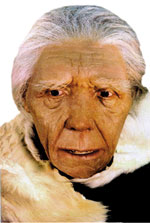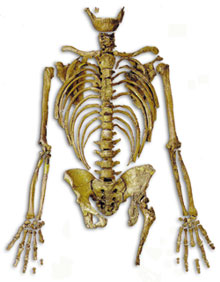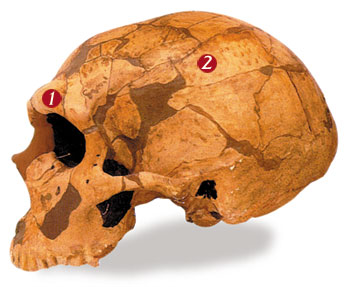A Lost Human Race: Neanderthals
Today, it has been definitively verified that Neanderthal man, who is presented as the "primitive ancestor of man" by evolutionists, is simply a lost human race.
Neanderthals are human beings who suddenly appeared 100,000 years ago in Europe and disappeared–or were assimilated by being blended with other races–quietly yet quickly 35,000 years ago. Their only difference from modern man is their skeleton being more robust and their cranial capacity slightly bigger.
 | Right: Trinkets made of bone, which belonged to the Neanderthals. |  |
Left: If we had seen a Neanderthal in the street today, we would think him or her to be no different from other people. |
Neanderthals are a human race and this fact is admitted by almost everybody today. Evolutionists have tried very hard to present them as "a primitive species", yet all findings indicate that they were no different from a "robust" man walking on the street today. A prominent authority on the subject, Erik Trinkaus, a paleoanthropologist from New Mexico University writes:
 | NEANDERTHALS AND ESKIMOS A comparison made between Neanderthal man and modern human races. To the far left and second from left are Neanderthal men. Neanderthals bear the greatest resemblance to Eskimos who live in cold climates today. |  |
NEANDERTHAL SKELETON Estimations based on bone fragments indicate that Neanderthals were physically stronger than modern man. |
Detailed comparisons of Neanderthal skeletal remains with those of modern humans have shown that there is nothing in Neanderthal anatomy that conclusively indicates locomotor, manipulative, intellectual, or linguistic abilities inferior to those of modern humans.55
Many contemporary researchers define Neanderthal man as a sub-species of modern man and call him "Homo sapiens neandertalensis". The findings testify that Neanderthals buried their dead, fashioned musical instruments, and had cultural affinities with the Homo sapiens sapiens living during the same period. To put it precisely, Neanderthals are a "robust" human race that simply disappeared in time.
 |
The skull of Neanderthal man differed slightly from that of modern man. 1. Neanderthal man had thick eyebrow projections just like those of the Australian natives living today. 2. The cranial capacity of Neanderthals was bigger than that of modern man by 150 cc. This finding refuted the evolutionist claim that "the brain got bigger over time." |
Footnotes
57) Erik Trinkaus, "Hard Times Among the Neanderthals", Natural History, Band 87, Aralik 1978, S. 10; R. L. Holloway, "The Neanderthal Brain: What Was Primitive", American Journal of Physical Anthropology Supplement, Band 12, 1991, S. 94
- An Outdated View: The Theory of Evolution
- The Origin of Life
- The Design in the Protein
- The Design in the Cell
- Genetic Information
- The Design in Nature
- Miller's Experiment
- The Natural Selection Misconception
- Mutations
- Irreducible Complexity
- Impasse of Intermediate Forms
- The Cambrian Period
- Fish and Amphibians
- Coelacanth Misconception
- Reptiles
- Birds and Reptiles
- Archaeopteryx Misconception
- Bird Feathers
- The Origin of Mammals
- Living Fossils
- The Tale of Man's Evolution
- Australopithecus
- Homo Erectus
- A Lost Human Race: Neanderthals
- The Collapse of the Family Tree
- The Bipedalism Impasse
- False Faces
- Piltdown Scandal
- Why is Evolution Defended?
- The Obvious Truth: Creation
